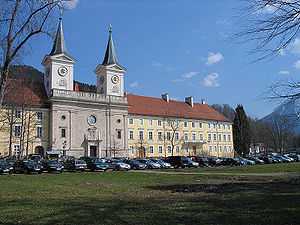Duke in Bavaria
Duke in Bavaria (German: Herzog in Bayern) was a title used among others since 1506, when primogeniture was established[citation needed], by all members of the House of Wittelsbach, with the exception of the Duke of Bavaria which began to be a unique position. So reads for instance the full title of Karl I, Count Palatine of Zweibrücken-Birkenfeld and patriarch of the House of Palatinate-Birkenfeld: "Count Palatine by Rhine, Duke in Bavaria, Count to Veldenz and Sponheim". The title grew in importance as Wilhelm, Count Palatine of Zweibrücken-Birkenfeld-Gelnhausen began to use it as his primary title. This choice has also had effect for his descendants.
Since 1799
On 16 February 1799, the head of the House of Wittelsbach Charles Theodore of Bavaria died without issue. Wittelsbach had been the ruling house of Bavaria since 1180 with the title of a Duke of Bavaria, and the higher title of an Elector of the Holy Roman Empire since 1648. As after the Landshut War of Succession primogeniture was established, there could only be one Duke of Bavaria anymore, resulting in the actually quite unprecedented decision to create a title of Duke in Bavaria for the rest of the family, which all members of the House took for themselves, even the older Palatine branch – the other major Wittelsbach possession. Reversely, all Wittelbachs were also Counts Palatine by Rhine. After Charles Theodore's death, who had unified Bavaria with the Palatinate and the other major possessions of Jülich and Berg in his person, two cadet branches were surviving: one headed by Maximilian I Joseph, Count Palatine of Zweibrücken, the other by William, Count Palatine of Gelnhausen, and both Zweibrücken and Gelnhausen were occupied by the French, which might explain why the custom was abandoned to name cadet branches by the title of their cadet possessions no matter how small.
The both agreed in the House Treaty of Ansbach that the Wittelsbach inheritances should be indivisible further on. Maximilian Joseph, as from the senior branch, inherited Charles Theodor's title of Elector of Bavaria, while William, his brother-in-law in addition to rather distinct a relative, was compensated with the title of Duke in Bavaria. As head of a specific family branch, it is possible since to speak somewhat paradoxically of The Duke in Bavaria. When Wittelsbach became a Royal House, the Dukes in Bavaria were lifted to the dignity of a Royal Highness. Then if not earlier, the title of Duke in Bavaria came into formal disuse by the Royal branch, who were quite content to be Princes of Bavaria. It should be kept in mind that even if we commonly speak of a Royal and a Ducal branch of the House, it was clear that the Dukes as well were of royal rank, and to make things more complicated, the head of the royal branch is now again called the Duke: the Duke of Bavaria, of course. Among the notable members of the Ducal branch were Duke Max, who, a talented Zither player and composer himself, ranks among the most important promoters of Bavarian folk-music; his daughters Empress Elisabeth of Austria, Queen of Hungary and Queen Mary Sophie of the Two Sicilies; and in more recent times Sophie, Hereditary Princess of Liechtenstein.
In 1965 there were only two male members of the family, Duke Ludwig Wilhelm and his cousin Duke Luitpold; both were elderly and had no children. On 18 March 1965 Duke Ludwig Wilhelm adopted Prince Max of Bavaria, the second son of Albrecht, Duke of Bavaria and the grandson of Ludwig Wilhelm's sister Marie Gabrielle. From this point onwards Max has used the surname "Herzog in Bayern" in place of the surname "Prinz von Bayern". Max has five daughters, including the Sophie mentioned already, all of whom were born with the surname "Herzogin in Bayern".
Ancestors
Wilhelm, the first Duke in Bavaria, was descended from the line of Palatinate-Zweibrücken-Birkenfeld-Gelnhausen. His ancestors were:
- Wolfgang, Count Palatine of Zweibrücken (1526–1569), m. Anna of Hesse.
- Karl I, Count Palatine of Zweibrücken-Birkenfeld (1560–1600), fifth son of Wolfgang, m. Dorothea of Brunswick-Lüneburg
- Christian I, Count Palatine of Zweibrücken-Bischweiler (1598–1654), third son of Karl, m. his cousin Magdalene Catherine of Zweibrücken, a daughter of John II, Count Palatine of Zweibrücken and Cathérine de Rohan.
- John Charles, Count Palatine of Gelnhausen (1638–1704), second surviving son of Christian I, m. Esther Marie of Witzleben. They were parents of several sons.
- John, Count Palatine of Gelnhausen (1698–1780), second son of John Charles, m. Sophie Charlotte of Salm-Dhaun, father of William, Duke in Bavaria.
- John Charles, Count Palatine of Gelnhausen (1638–1704), second surviving son of Christian I, m. Esther Marie of Witzleben. They were parents of several sons.
- Christian I, Count Palatine of Zweibrücken-Bischweiler (1598–1654), third son of Karl, m. his cousin Magdalene Catherine of Zweibrücken, a daughter of John II, Count Palatine of Zweibrücken and Cathérine de Rohan.
- Karl I, Count Palatine of Zweibrücken-Birkenfeld (1560–1600), fifth son of Wolfgang, m. Dorothea of Brunswick-Lüneburg
Dukes in Bavaria
If we take 1799 as the beginning of somewhat a House of its own, the heads of this house were:
- William (1789/99-1837), (The) Count Palatinate of Gelnhausen 1789, Duke in Bavaria (roughly) 1799
- Pius August (1837)
- Max Joseph (1837–1888)
- Charles Theodore (1888–1909) due to abdication of his elder brother on account of his morganatic marriage
- Louis William (1909–1968)
- After his death, his cousin Luitpold Emanuel (lived 1890-1973) remained the last natural member of the family.
- Max Emanuel, adopted, since 1968.
The members of the family used the title Duke or Duchess in Bavaria, with the style of Royal Highness.
Family tree
- Wilhelm (1752–1837), second son[1] of Johann, m. 1780 Countess Palatine Maria Anna of Birkenfeld (1753–1824), and had issue:
- Maria Elisabeth Amalie Franziska (1784-1849), m. 1808 Louis Alexandre Berthier, sovereign Prince of Neuchâtel (1753-1815), and had issue.
- Pius August (1786-1837), m. 1807 Princess and Duchess Amélie Louise of Arenberg (1789-1823), and had issue:
- Maximilian Joseph (1808-1888), m. 1828 Princess Ludovika of Bavaria (1808-1892) and had issue:
- Ludwig Wilhelm (1831-1920), left morganatic issue through his surviving daughters.[2]
- Wilhelm Karl (1832-1833).
- Helene (1834-1890), m. 1858 Maximilian Anton Lamoral, Hereditary Prince of Thurn and Taxis (1831-1867) and had issue.
- Elisabeth (1837-1898), m. 1854 Emperor Franz Josef of Austria (1830-1916) and had issue.
- Karl Theodor (1839-1909), m. 1865 Princess Sophie of Saxony (1845-1867) and had issue:
- Amalie Marie (1865-1912), m. 1892 Duke Wilhelm of Urach (1864-1928) and had issue.
- m. secondly 1874 Infanta Maria Josefa of Portugal (1857-1943) and had further issue:
- Sophie (1875-1957), m. 1898 Count Hans Viet of Toerring-Jettenbach (1862-1929) and had issue.
- Elisabeth (1876-1965), m. 1900 King Albert I of the Belgians (1875-1934) and had issue.
- Marie Gabrielle (1878-1912), m. 1900 Crown Prince Rupprecht of Bavaria (1869-1955) and had issue.
- Ludwig Wilhelm (1884-1968), m. 1917 Princess Eleonore of Sayn-Wittgenstein-Berleburg (1880-1965); in 1965 he adopted:
- Prince Max of Bavaria (born 1937), grandson of Marie Gabrielle, who thereby became Duke in Bavaria; he m. 1967 Countess Elizabeth Douglas (born 1940) and has issue:
- Sophie (born 1967), m. 1993 Hereditary Prince Alois of Liechtenstein (born 1968) and has issue.
- Marie Caroline (born 1969), m. 1991 Duke Philipp of Württemberg (born 1964) and has issue.
- Helene (born 1972).
- Elizabeth (born 1973), m. 2004 Dr. Daniel Terberger (born 1967) and has issue.
- Anna (born 1975), m. 2007 Klaus Runow (born 1964).
- Franz Josef (1888-1912).
- Maria Sophie (1841-1925), m. 1859 King Francesco II of the Two Sicilies (1836-1894) and had issue.
- Mathilde Ludovika (1843-1925), m. 1861 Prince Lodovico of the Two Sicilies, Count of Trani (1838-1886) and had issue.
- Sophie Charlotte (1847-1897), m. 1868 Prince Ferdinand of Orléans, Duke of Alençon (1844-1910) and had issue.
- Maximilian Emanuel (1849-1893), m. 1875 Princess Amalie of Saxe-Coburg and Gotha (1848-1894) and had issue:
- Siegfried (1876-1952).
- Christoph (1879-1963), m. 1924 Anna Sibig (1874-1958).
- Luitpold (1898-1973).
Homes
In 1813 Duke Wilhelm in Bavaria acquired a former monastery after its secularisation, the Franconian Banz Abbey. His grandson Duke Maximilian Joseph in Bavaria purchased Possenhofen Castle on Lake Starnberg which became his major residence and where his children, notably the later Empress Elisabeth of Austria, Queen of Hungary ("Sisi"), were brought up. In 1838 he acquired Unterwittelsbach Castle (today housing a "Sisi" museum) near the site of Burg Wittelsbach, the ancestral seat of the House of Wittelsbach. His wife, Princess Ludovika of Bavaria, daughter of King Maximilian I Joseph of Bavaria, inherited the Upper Bavarian Tegernsee Abbey, purchased in 1817 by king Maximilian I Joseph, together with the nearby bath house at Kreuth.
Luitpold Emanuel Ludwig Maria, Duke in Bavaria (1890-1973), the last issue of the in Bavaria junior branch, sold Possenhofen and Schloss Biederstein in Munich in order to finance his late romantic Schloss Ringberg. His cousin Duke Ludwig Wilhelm in Bavaria, also childless, in 1965 had adopted the grandson of his sister Marie Gabrielle, Prince Max Emanuel of Bavaria of the senior royal branch, who inherited the estates at Banz, Tegernsee and Kreuth from his uncle and, from his father's side, Wildenwart Castle near Frasdorf, which in 1862 had been purchased by Francis V, Duke of Modena who left it to his niece, the Bavarian Queen Maria Theresa.
-

Unterwittelsbach Castle
-

The house of Duke Maximilian Joseph in Munich
-
The bath house ("Wildbad") Kreuth
-

Wildenwart Castle
External links
- Marek, Miroslav. "The descendants of Wilhelm, Count Palatine of Zweibrücken-Birkenfeld-Gelnhausen". Genealogy.EU.



